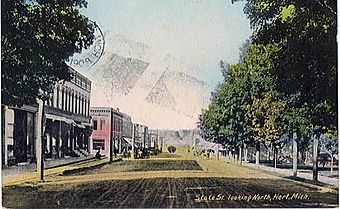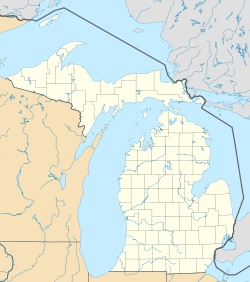Hart Downtown Historic District facts for kids
Quick facts for kids |
|
|
Hart Downtown Historic District
|
|

State Street looking north, c. 1908
|
|
| Location | Along S. State St., roughly bounded by Main, Dryden, Water, and Lincoln Sts, Hart, Michigan |
|---|---|
| Architectural style | Late Victorian, Classical Revival, Modern |
| NRHP reference No. | 15000814 |
| Added to NRHP | November 24, 2015 |
The Hart Downtown Historic District is a special area in Hart, Michigan. It's a historic part of the city center, mainly along South State Street. This district was added to the National Register of Historic Places in 2015. This means it's recognized as an important place in American history.
Contents
- History of Hart's Downtown
- What You'll See There
- Cool Buildings to Spot
- Charles A. and Carrie Gurney House
- John V. and Lydia E. Cahill House
- Mahar Wigton House
- Chadwick-Munger House
- Hart Auto Company / Kunkle Manufacturing Co.
- Noret Block
- First National Bank of Hart
- County Courthouse Complex
- Ben Franklin Store Building
- Amuse Theater
- Hatch-Denison Block
- Masonic Temple
- United States Post Office
- United Home Telephone Exchange
- Cool Buildings to Spot
History of Hart's Downtown
The first European settlers arrived in the Hart area around 1855-1856. The town of Hart began when Elbridge G. Farmer started building a sawmill by the river. This mill was finished in 1862 by Lyman B. Corbin. Soon after, a place for workers to live was built.
In 1864, this small settlement was chosen as the main town for Oceana County. A post office opened that same year. By 1865, the first general store was built in what is now the historic district. A hardware store followed in 1866, and the first county buildings were ready by 1868. By 1873, about 600 people lived in Hart.
The town grew quickly because of the timber industry. Many businesses related to lumber, like planing mills, opened. By 1883, downtown Hart had at least 40 businesses! Around this time, the first brick buildings were constructed. After several fires in the village, brick became the main material for new buildings. By 1900, most buildings in the district were made of brick.
New brick buildings continued to replace older ones in the early 1900s. Building slowed down a lot during the Great Depression. After World War II, some older buildings were destroyed by fires. Newer, more modern buildings were built in their place. Some older buildings were also updated, changing the look of Hart's streets.
What You'll See There
The Hart Downtown Historic District is the main business area of the city. It includes many buildings along three blocks of State Street, plus a few nearby. Most buildings are for businesses, but there are also some homes and government buildings.
The buildings were built at different times. Newer ones often replaced older structures after fires or demolition. There are 57 buildings in the district. About 37 of them are considered "historic." This means they still show their original look and feel. The other 20 are newer or have been changed a lot. Most buildings are one or two stories tall. They are often made of brick or concrete block. You can see different styles like Italianate, Art Moderne, and Mid-Century Modern.
Cool Buildings to Spot
Here are some of the interesting historic buildings you can find in the district:
Charles A. and Carrie Gurney House
This two-story brick house was built in 1893 for Charles A. Gurney. He was a local lawyer and pharmacist. The house has a style called Italianate. Its windows are stacked in pairs. A small front porch is there now, but it used to have a bigger one.
John V. and Lydia E. Cahill House
Built around 1893, this two-story house belonged to John V. Cahill. He was a wagon maker and owned part of a hardware store. The house has a steep front roof that goes up high. It has two front doors and a long row of windows. An addition was built in 1920, and the front was later updated to look like an English Cottage.
Mahar Wigton House
This two-story house was likely built between 1881 and 1883 for Mahar Wigton. It has an enclosed porch with a small octagon-shaped window. There are also two bay windows that stick out from the house. The second floor has five double-hung windows.
Chadwick-Munger House
This house, built in 1893, is special because it's covered in fieldstone. It was built for Dr. Harvey J. Chadwick, a doctor and pharmacist. Later, it was owned by Louis P. and Edith Munger. Edith was important because she was the first female president of the Michigan Audubon Society! Today, the Oceana County Historical Society owns the house. It has a hipped roof with dormer windows.
Hart Auto Company / Kunkle Manufacturing Co.
This large, two-story building on East Main Street was built in four parts between 1914 and 1929. The oldest part was a Ford Service Garage for the Hart Auto Company. It has cool brick designs. Later, the Kunkle Manufacturing Company, which made car parts, added a factory section.
Noret Block
This two-story brick building from 1899 has three storefronts. E.A. Noret, an early developer, built it quickly. It was fully rented by 1900. The second floor has square windows with stone tops. The first floor has large windows on either side of a recessed entrance for each store.
First National Bank of Hart
This impressive two-story building was built in 1927-1928. It was designed by a company that specialized in banks. It has a grand front porch with two large columns. This bank was one of the first in Hart, starting in 1874. Today, Huntington Bank still operates in this historic building.
County Courthouse Complex
The County Courthouse complex at 100 South State Street includes a few buildings. There's a Civil War Monument from 1903. The main courthouse building was built in 1957-1958. It's a one-story building with light yellow and red brick. The Sheriff Department and Jail, built in 1968, is similar. The Civil War Monument shows a soldier standing at rest.
Ben Franklin Store Building
This building, located at 19-23 South State Street, was originally two separate buildings. One part was built in the late 1800s, and the other in 1917-1919. In 1939, Robert Dorsh bought both and turned them into one building. He opened a Ben Franklin variety store there. The front of the building now has a large glass storefront on the first floor.
Amuse Theater
Built in 1927, this two-story building at 27 South State Street was home to the Amuse Theatre. The theater could seat 400 people! The upper part of the building is covered in white bricks with green decorative bricks. The lower part of the building has been changed over time.
Hatch-Denison Block
This two-story brick building from 1889 is in the Italianate style. It has two very different storefronts on the first floor. The second story has three double-hung windows above each storefront.
Masonic Temple
This two-story building was built in 1884. It was home to the Masonic Hall for many years. The building was completely updated in 1961. The first floor has one entrance that is not in the center. The second floor has three windows.
United States Post Office
This single-story post office was built in 1939. It was designed by Louis A. Simon, who designed many post offices across the country. It's made of red brick with limestone trim. Inside, there's a special mural called "Boy Rounding up the Stick."
United Home Telephone Exchange
This two-story red brick building from 1916 was used for the United Home Telephone Company offices. This company provided phone service to several counties. The first floor has a small entry porch.



